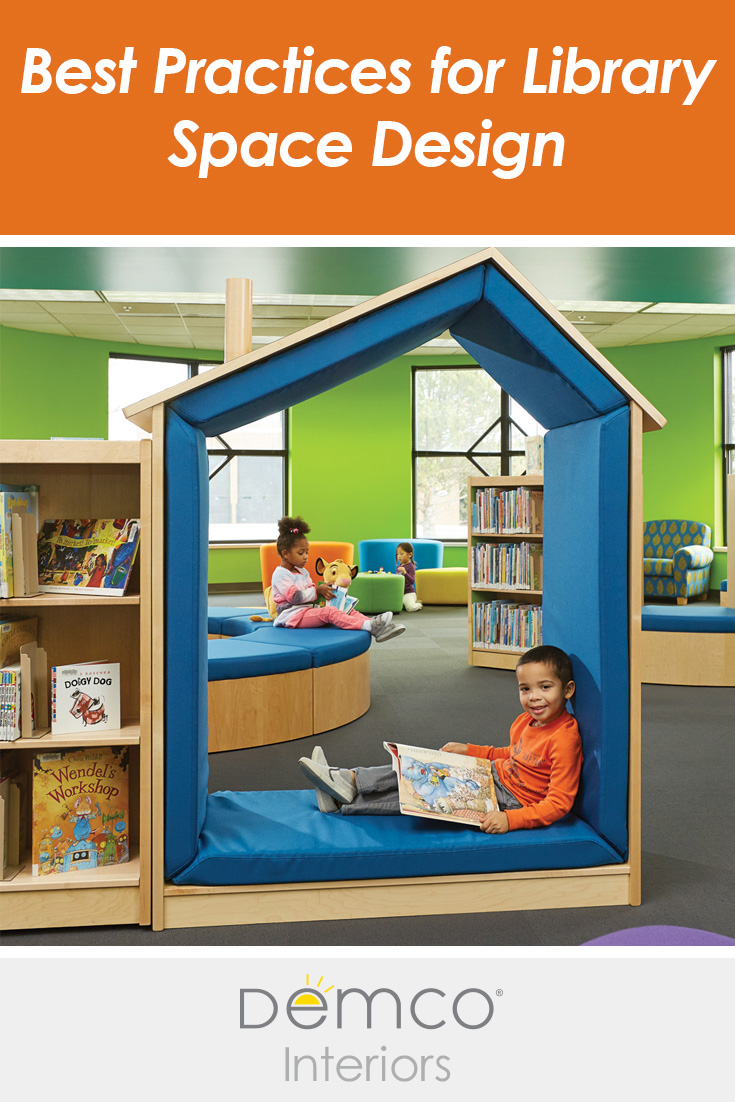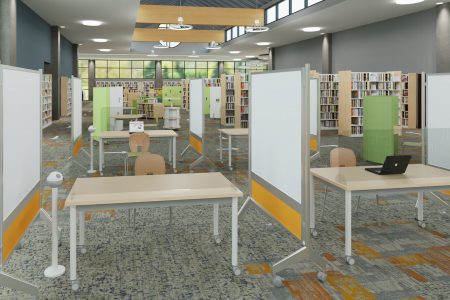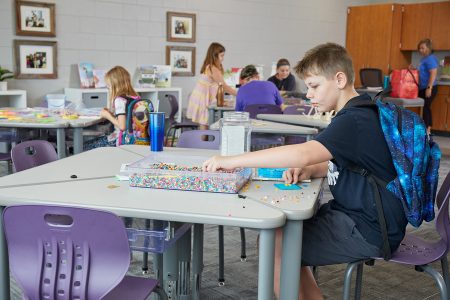If your library is ready for some updates or you’re getting ready to embark on a complete redesign, you want to make sure your dollars are well spent and you’re following library design best practices.
Although every library and every community has different needs, the following guidelines will help as you plan your project.
Early Literacy Areas
- Strategically place carpets for the safety of children who are crawling, learning to walk, and actively interacting with the space.
- Include engaging posters, artwork, and other visually appealing items in your space.
- Use pictorial signage and images to help young, nonreading patrons find their way through your collections and your library spaces.
- Provide a variety of experiences that encourage individual exploration as well as group play.
Furnishings
- Include child-size furnishings for kids to sit on by themselves or to interact with one another.
- Incorporate floor cushions or other soft seating (10″H) for storytime and other programs.
- Display picture books and board books in floor-level, face-out book browsers to promote discovery.
- Provide adult-size seating for caregivers to interact with their children as well as other grown-ups.
- Arrange the space in a way that provides clear sight lines to play and collection spaces.
Interactives
- Engage all the senses in learning using interactive panels and tables, learning walls, flannel boards, puppet theaters, and stages.
- Give young kids natural gathering spots like play kitchens, train tables, general store sets, and farm stands.
Organization
- Provide storage bins and shelving labeled with both words and pictures for easy organizing.
Children’s Spaces
 Have as many inviting areas as possible to attract a variety of ages and interests.
Have as many inviting areas as possible to attract a variety of ages and interests.- Provide comfortable, quiet library spaces for studying and recreational reading, as well as social spaces.
- Create a collaboration space for group work with reconfigurable mobile furniture.
- Include chairs with 14″H seats paired with 22–25″H tabletops.
- Make materials accessible by keeping shelving heights at 48″. Perimeter shelving can go up to 66″ if needed.
- Incorporate displays and storage systems that will enhance the visibility and accessibility of the collection.
- Include interactive elements throughout the area, such as magnetic poetry, whiteboard walls, art gallery space, and board games.
- Invite readers to discover books by using face-out book browsers.
- Create a large-group programming and event space with reconfigurable furniture that can serve a variety of purposes and adapt as needed.
- Designate an area for kids to create and make to express their creativity.
- Provide a safe atmosphere with nearby amenities such as seating, resources, and power access so caregivers can easily keep an eye on their children.
Teen Zones
 Allow teens to take ownership of the space by creating a teen advisory board to give input on the space design, furnishings, and programming.
Allow teens to take ownership of the space by creating a teen advisory board to give input on the space design, furnishings, and programming.- Comfortable furnishings are essential, as well as active seating for users who need to keep in motion.
- Keep the space flexible to support a variety of experiences, from live performances to hanging out to movie nights and more.
- Provide access to technology and support the use of personal devices.
- Encourage kids to develop and express their identities through art and creation.
- Grow access to digital media labs and makerspaces as resources permit.
- Provide adaptable library spaces to engage with others to problem-solve, collaborate, and share content.
- Promote individual learning and reading with engaging and interactive displays.
Makerspaces
 Choose work surfaces compatible with the various activities taking place.
Choose work surfaces compatible with the various activities taking place.- Look for mobile furnishings that allow you to easily adapt the space for different activities.
- Include seating and tables in a variety of heights to accommodate users’ needs.
- Choose maker tools based on the needs and interests of your community.
- Consider electrical and mechanical needs, such as ventilation.
- Plan for storage — open, locking, and/or mobile.
- Consider dry-erase room dividers to divide the space for various age groups.
- Plan space for passive programming, small-group work, and expert-led workshops.
Community and Meeting Rooms
 Provide work surfaces that can be reconfigured for varying group sizes, including individual, small-group, and presentation-style.
Provide work surfaces that can be reconfigured for varying group sizes, including individual, small-group, and presentation-style.- Consider integrated technology and AV needs.
- Look for tables that fold, roll, and nest, as well as stackable seating to open floor space when needed.
- Use freestanding, lightweight screens or mobile markerboards to create activity zones.
Common Areas and Shelving
 Use mobile shelving to allow areas to be reconfigured as collections and needs change.
Use mobile shelving to allow areas to be reconfigured as collections and needs change.- Keep shelving low in areas where you want to maintain clear sight lines.
- Provide a mix of seating and work surfaces, including comfortable lounge furniture to draw visitors in.
- Supply access to power throughout your library spaces, using mobile power sources, powered furniture, and wireless charging areas.
- Lower library shelving to extend natural daylight farther into the building.
- Use furniture and shelving to designate smaller spaces without walls.
Entryways and Circulation Desk
 Equip your welcome space with clear signage, retail-like displays, and anything that promotes the activities and programs at the library.
Equip your welcome space with clear signage, retail-like displays, and anything that promotes the activities and programs at the library.- Opt for modular circulation desk pieces to allow for future reconfiguration with minimal disruption and cost.
- Consider adding multiple mobile service points throughout your library spaces.
- Use a variety of displays to merchandise materials.
- Use clear signage for wayfinding throughout.
Liz Bowie
Marketing Content Manager at Demco, Inc.
Liz is the Marketing Content Manager for Demco. Her background includes editorial management and product development of innovative and time-saving tools for schools and libraries, with an emphasis on Common Core, literacy and math. The products she and her team have developed, including classroom games, learning centers and professional development resources, have garnered 46 industry awards for excellence in education. Liz is passionate about promoting literacy through her work and the work of others. If you are interested in sharing your ideas and programming tips on Demco’s Ideas and Inspiration blog or have ideas for topics you’d like to see covered, contact Liz at lizb@demco.com
Latest posts by Liz Bowie (see all)
- 3 Things You Hate About Your Learning Space (and How to Fix Them) - April 8, 2020
- Modern Learning Spaces: What the Research Tells Us - January 29, 2020
- Best Practices for Library Furniture and Space Design - May 20, 2019
- 4 Mistakes You Don’t Want to Make When Redesigning Your Learning Space - April 15, 2019
- Why Educators Love Flexible Seating - October 31, 2018





